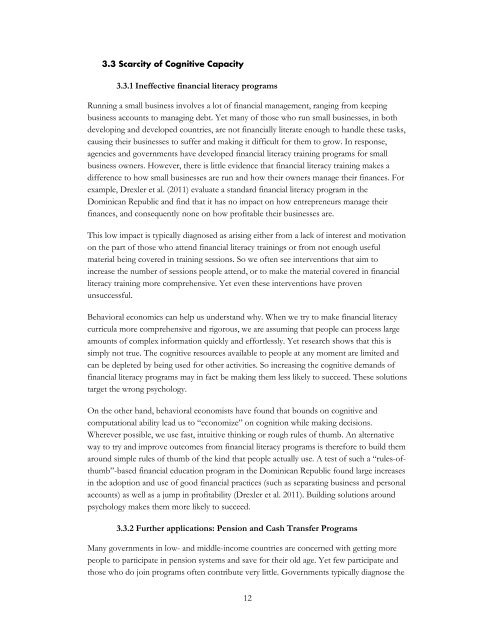1426679 file datta mullainathan behavioral design
1426679 file datta mullainathan behavioral design
1426679 file datta mullainathan behavioral design
Create successful ePaper yourself
Turn your PDF publications into a flip-book with our unique Google optimized e-Paper software.
3.3 Scarcity of Cognitive Capacity<br />
3.3.1 Ineffective financial literacy programs<br />
Running a small business involves a lot of financial management, ranging from keeping<br />
business accounts to managing debt. Yet many of those who run small businesses, in both<br />
developing and developed countries, are not financially literate enough to handle these tasks,<br />
causing their businesses to suffer and making it difficult for them to grow. In response,<br />
agencies and governments have developed financial literacy training programs for small<br />
business owners. However, there is little evidence that financial literacy training makes a<br />
difference to how small businesses are run and how their owners manage their finances. For<br />
example, Drexler et al. (2011) evaluate a standard financial literacy program in the<br />
Dominican Republic and find that it has no impact on how entrepreneurs manage their<br />
finances, and consequently none on how profitable their businesses are.<br />
This low impact is typically diagnosed as arising either from a lack of interest and motivation<br />
on the part of those who attend financial literacy trainings or from not enough useful<br />
material being covered in training sessions. So we often see interventions that aim to<br />
increase the number of sessions people attend, or to make the material covered in financial<br />
literacy training more comprehensive. Yet even these interventions have proven<br />
unsuccessful.<br />
Behavioral economics can help us understand why. When we try to make financial literacy<br />
curricula more comprehensive and rigorous, we are assuming that people can process large<br />
amounts of complex information quickly and effortlessly. Yet research shows that this is<br />
simply not true. The cognitive resources available to people at any moment are limited and<br />
can be depleted by being used for other activities. So increasing the cognitive demands of<br />
financial literacy programs may in fact be making them less likely to succeed. These solutions<br />
target the wrong psychology.<br />
On the other hand, <strong>behavioral</strong> economists have found that bounds on cognitive and<br />
computational ability lead us to “economize” on cognition while making decisions.<br />
Wherever possible, we use fast, intuitive thinking or rough rules of thumb. An alternative<br />
way to try and improve outcomes from financial literacy programs is therefore to build them<br />
around simple rules of thumb of the kind that people actually use. A test of such a “rules-ofthumb”-based<br />
financial education program in the Dominican Republic found large increases<br />
in the adoption and use of good financial practices (such as separating business and personal<br />
accounts) as well as a jump in profitability (Drexler et al. 2011). Building solutions around<br />
psychology makes them more likely to succeed.<br />
3.3.2 Further applications: Pension and Cash Transfer Programs<br />
Many governments in low- and middle-income countries are concerned with getting more<br />
people to participate in pension systems and save for their old age. Yet few participate and<br />
those who do join programs often contribute very little. Governments typically diagnose the<br />
12


